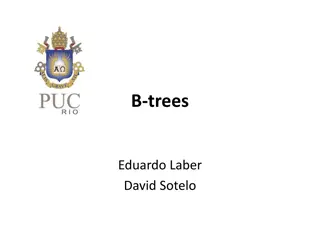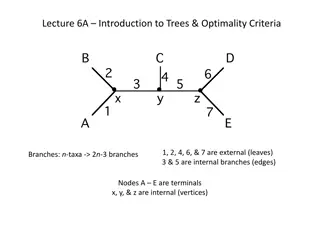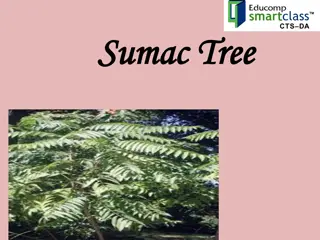Explore Fruit-Yielding Trees: Mango, American Plant, Citron
Discover the characteristics, uses, and benefits of three different fruit-yielding trees - Mango (Mangifera Indica), American Plant (Family: Myrtaceae), and Citron (Citrus Medica). Learn about their native regions, physical descriptions, nutritional values, and traditional uses. From furniture-making to medicinal properties, these trees offer a range of resources for various purposes.
Download Presentation

Please find below an Image/Link to download the presentation.
The content on the website is provided AS IS for your information and personal use only. It may not be sold, licensed, or shared on other websites without obtaining consent from the author. Download presentation by click this link. If you encounter any issues during the download, it is possible that the publisher has removed the file from their server.
E N D
Presentation Transcript
FRUIT YIELDING TREES Dr. R. RAJA JENCY ESTHER Assistant Professor Department of Botany Sarah Tucker College
MANGIFERA INDICA FAMILY : ANACARDIACEAE TAMIL NAME : MAAMARAM
DESCRIPTION NATIVE South east Asia, Indomalayan region Large evergreen tree Leaves simple, petiolate, alternate, irregularly placed along the branchlets. Flowers greenish yellow, scented, panicle Fruits drupe. March and July.
USES Furniture, floor, ceiling board, window frames and agriculture implements. Rich source vitamin A and C Bark astringent diptheria and rheumatism Kernel dysentery and stomach ache Leaves antidote Unripe fruits opthalmia and eruptions Hindus and buddhist sacred tree.
FAMILY : MYRTACEAE TAMIL NAME : KOYYA
DESCRIPTION American plant Small tree Leaves ovate to elliptic nerves prominent, softly hairy beneath
Flower Flowers large, white, axillary peduncles. Flowering August to October
FRUITS Fruits globose, ovoid berry. Seeds many, subreni form testa hard.
USES Bark decoction diarrhoea Fruits vitamins, tannins and minerals Fruit pulp jelly Leaves clean the teeth, cure toothache, Indigestion and intestinal gas.
CITRUS MEDICA FAMILY : RUTACEAE TAMIL NAME : NAARTHAI
DESCRIPTION Slow growing shrub or small tree. Height 8 to 15 ft Irregular straggling branches, long spines Lemon scented serrate edges, ovate lanceolate Petioles wingless or with minor wings
Fruit large berry, oblong or globose, juicy, rind leathery
USES Unripe fruit narthangai salted preserve Tender leaves narthallai podi. Sea sicknmess, pulmonary and intestinal disorder, dysentery, diarrhoea, gastric acidity, stimulates functioning of liver. Flatulence and vomiting.
CITRUS AURANTIFOLIA FAMILY : RUTACEAE TAMIL NAME: ELUMICCAI
DESCRIPTION Throughout India Much branched thorny shrub Unifoliately compound, rachis winged. Leaflets elliptic to oblong, alternate, coriaceous
Flowers white, large, pulp pale , seeds many, testa coriaceous.
USES Sour, themogenic, digestive, carminative, stomachic, laxative, anthelmintic, stimulant, antiseptic and mosquito repellent. Treatment of dyspepsis, flatulence, colic, constipation, helminthiasis, scabies, fatigue, halitosis, vomiting, cough, bronchitis and heart burn.
FAMILY : MYRTACEAE TAMIL NAME : NAVAL
DESCRIPTION Native India, distributed Malaysia, Phillipines, Srilanka and Thailand. Tall, evergreen tree Leaves lanceolate, ellliptic to obovate, glabrous, shiny above, leathery nerves .
Flowers white, scented, panicles May to August Fruits ovoid, one seeded, pulpy, deep purple, juicy and shining, cup limb of calyx tube. September and October.
USES Ripe fruit eaten fresh. Leaves fodder Flowers high quality honey Wood durable in water and resistant to termites. Boat building, agricultural implements, tool handles, cart wheels, sleepers and furniture. Building bridges, musical instruments, especially guitars Seeds and bark dysentery, diabetes. Fruits make wine.
CORDIA OBLIQUA FAMILY : CORDIACEAE TAMIL NAME : OTTTUPAZHAM
DESCRIPTION Moderate sized tree. Leaves broadly ovate, toothed, glabrous. Flowers panicles. Small, white Fruit drupe with a sharp point apex Fruiting season july and august.
USES FRUITS expectorant, treating the diseases of the lungs Gums gonorrhoea Fruits treating cough, chronic fever, spleen diseases. Raw fruits vegetable, pickle. Mucilaginous substance gum for pasting sheets of paper, card board.
ANNONA SQUAMOSA FAMILY : ANNONACEAE TAMIL NAME : SITAMARAM
DESCRIPTION Native South America and West indies Low straggling tree -6m. Leaves alternate, oblong, peculiar smell. Flowers greenish, solitary- april to september. Fruits green, fleshy, irregularly globose with numerous black seeds.
USES Fruits edible Roots purgative Seeds , fruits and leaves fatal to insects Mixed with gram flour for killing lice in the hair.
FAMILY : PUNICACEAE TAMIL NAME : MAATHULAI
DESCRIPTION Native Iran Leaves opposite, glossy, narrow oblong, entire. Flowers bright red, 5 petals Fruit berry, rounded hexagonal shape, thick reddish skin. Seeds 200-1400, surrounds water laden pulp.
USES Rind fruit and bark diarrhoea, dysentery and intestinal parasites. Seeds and juice tonic heart and throat Blood builder Flower juice, rind and tree bark astringent stopping nose bleeds and gum bleeds. Seeds abortifacient.























